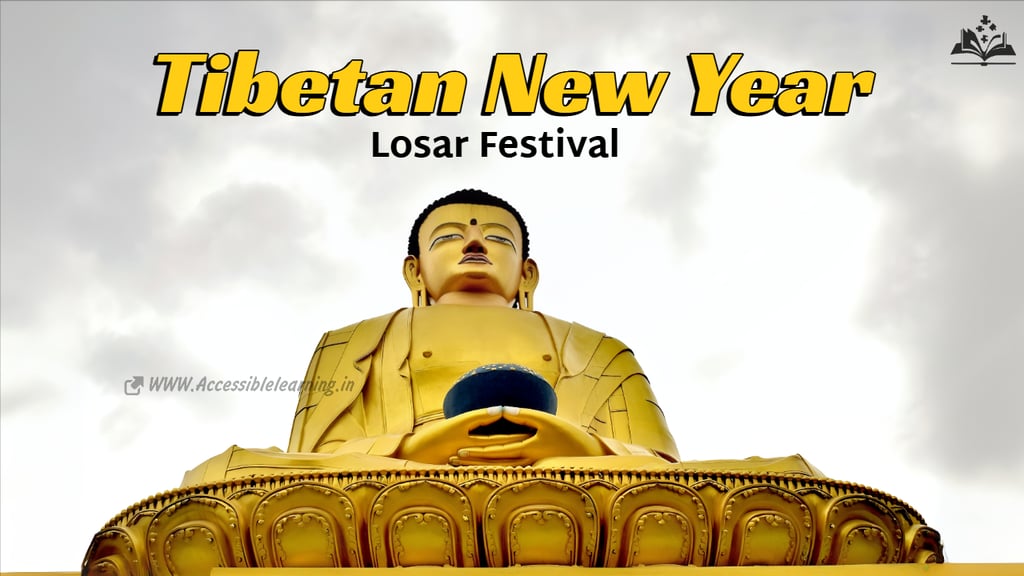
Tibetan New Year (Losar): Ancient Customs for a Modern World
The Losar Festival is the vibrant Tibetan New Year celebration filled with rich traditions, spiritual rituals, cultural performances, and community gatherings. Discover its history, significance, and how it continues to inspire hope and harmony worldwide.
EVENT/SPECIALTRAVEL LIFEEDUCATION/KNOWLEDGECELEBRATION/FESTIVALSINDIA & CHINE
Kim Shin
1/31/20254 min read


Losar, the Tibetan New Year, is a vibrant cultural festival that heralds a fresh start, rooted in deep spiritual traditions, community unity, and the celebration of life. Observed by Tibetans and many Himalayan communities, Losar represents a time to bid farewell to the old year, cleanse negative energies, and welcome prosperity, peace, and happiness. Its significance transcends mere festivity, weaving together religious practices, family bonding, and cultural preservation.
Origins and Historical Significance
The word "Losar" translates to "New Year" (Lo = year, Sar = new) in Tibetan. Its origins trace back over 2,000 years to the pre-Buddhist era of the Bon religion. During this period, indigenous Tibetans marked the arrival of the new year by offering incense to local deities and spirits to ensure protection and a bountiful harvest.
With the advent of Buddhism in Tibet during the 7th century, Losar was infused with Buddhist customs, aligning with the lunar calendar. This amalgamation gave Losar its unique identity, blending spiritual traditions with secular festivities. Historically, the festival also marked the conclusion of agricultural cycles, offering farmers an opportunity to rest and celebrate after the harvest season.
When Is Losar Celebrated?
Losar usually falls in late January or February, depending on the lunar calendar. The festival lasts for 15 days, but the first three days are the most important. Each day carries a distinct set of customs and rituals:
Day 1 (Tseden Shakpa): Preparations and spiritual rituals dominate the day, where families make offerings at home and monasteries.
Day 2 (Gyalpo Losar): This is the main day of celebration, featuring social festivities, cultural performances, and gatherings.
Day 3: Prayers and offerings to Buddhist deities, as well as acts of generosity like donating food and clothing to those in need, take center stage.
Rituals and Traditions of Losar
Preparations Before Losar
The weeks leading to Losar are filled with activities to cleanse and prepare homes. Families engage in a practice called "Gutuk," where a special noodle soup is prepared and consumed to drive away negativities. Ritualistic cleaning of homes, decorating altars with offerings, and painting traditional designs on walls are common.
Another intriguing custom is the preparation of the "Chemar Box," a wooden container filled with roasted barley flour (tsampa) and butter, which symbolizes prosperity and good fortune. The Chemar Box is placed on altars and used in ceremonies.
Religious Ceremonies
Monasteries play a central role during Losar. Devotees participate in prayers, chanting, and lighting butter lamps to seek blessings for the coming year. Monks conduct rituals to dispel evil spirits and bring peace to the community. The Cham dance, performed by monks in elaborate costumes and masks, depicts the triumph of good over evil and serves as an offering to deities.
Special prayers are also offered to Palden Lhamo, the protector deity of Tibet, for national and personal well-being.
Feasting and Traditional Foods
The Losar feast is an essential part of the celebrations. Families prepare traditional delicacies like:
Khapse: Fried pastries in intricate shapes, symbolizing abundance.
Chang: A fermented barley beer, enjoyed during social gatherings.
Dresi: Buttered rice with raisins, served as a sweet dish.
A unique aspect of Losar cuisine is the inclusion of symbolic ingredients in dishes. For example, Gutuk contains hidden items like chili, wool, or coins, each carrying a humorous or symbolic meaning, reflecting the person’s personality or fortune for the coming year.
Festive Attire and Social Gatherings
People don vibrant traditional attire made from silk and wool, reflecting Tibetan artistry. Community gatherings feature singing, dancing, and the exchange of "Tashi Delek" (auspicious greetings), symbolizing goodwill. Elders bless the younger generation, and families exchange gifts to strengthen bonds.
Cultural Performances
Folk songs, dances, and plays are performed to narrate historical tales and mythological stories. These cultural activities ensure the preservation of Tibetan heritage and instill pride among the younger generation. The Yak Dance and Snow Lion Dance are among the most popular performances, symbolizing prosperity and courage.
Symbolic Practices
Prayer flags are hoisted during Losar to spread compassion and blessings. The flags flutter in the wind, symbolizing the transmission of prayers across the world. Another important ritual involves lighting butter lamps to dispel darkness and ignorance, inviting wisdom and clarity.
Regional Variations of Losar
While Losar is widely celebrated in Tibet, its observance varies across regions like Ladakh, Sikkim, Bhutan, and Arunachal Pradesh. In Bhutan, Losar aligns with the Dzongkha calendar and involves a strong emphasis on archery contests. Ladakhi Losar, on the other hand, features unique practices like burning sacred juniper leaves to invoke blessings.
The Sherpa community in Nepal celebrates Losar with similar enthusiasm, focusing on family gatherings, religious rituals, and communal feasting. Despite regional differences, the essence of Losar—renewal and harmony—remains universal.
The Spiritual Essence of Losar
At its heart, Losar is not just a celebration of the new year but a time for spiritual reflection and renewal. It embodies gratitude for the past, mindfulness of the present, and hope for the future. The rituals emphasize impermanence, encouraging individuals to let go of attachments and embrace positivity.
The use of prayer flags during Losar symbolizes spreading compassion and blessings to all sentient beings. Similarly, the lighting of butter lamps represents the illumination of wisdom, dispelling ignorance and darkness.


Modern-Day Significance
In contemporary times, Losar serves as a unifying festival for Tibetan communities across the globe. Despite political challenges, the Tibetan diaspora continues to preserve this cultural treasure, often integrating modern elements like concerts, exhibitions, and public events.
Social media has also played a role in connecting Tibetan communities, allowing them to share Losar celebrations and traditions with a global audience. Organizations and cultural groups actively promote the festival to ensure that younger generations stay connected to their roots.
The Losar Festival is a kaleidoscope of spirituality, culture, and joy. It not only honors Tibetan heritage but also offers profound life lessons about resilience, gratitude, and hope. As the butter lamps flicker and prayers echo through the Himalayan valleys, Losar serves as a reminder of the universal human desire for renewal and harmony.
By embracing the essence of Losar, we, too, can find inspiration to approach the new year with positivity and compassion.
Subscribe to our newsletter
All © Copyright reserved by Accessible-Learning
| Terms & Conditions
Knowledge is power. Learn with Us. 📚


